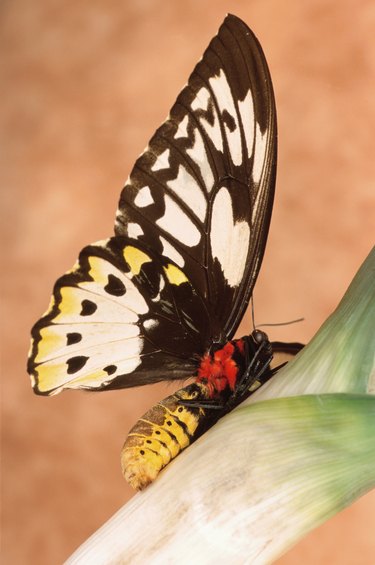
Horticulturalists and farmers usually describe caterpillars as pests since they cause damage by eating vegetation. For instance, caterpillars are responsible for approximately 60 to 70 percent of insect damage in cotton fields. However, certain wildlife and plant species benefit from the presence of caterpillars. Caterpillars also benefit the environment as butterflies, the adult stage for caterpillars.
Food Source
Video of the Day
Larger wildlife species such as birds and small mammals feed on caterpillars as part of their diets. Bears, hedgehogs and rodents have an appetite for caterpillars, while passerine birds (tree-dwelling birds) such as woodpeckers and songbirds hunt for caterpillars. Since animals eat caterpillars in the wild, the University of Minnesota's Extension program advises landowners not to spray chemical insecticides in large forests to eliminate caterpillars. However, the school also says aircraft spraying is an option for high levels of caterpillar infestations. Animals hunt for caterpillars in the spring and summer, before caterpillars develop cocoons.
Video of the Day
Butterflies
During the late autumn and winter, caterpillars wrap themselves in a cocoon and begin the metamorphosis into a butterfly. When they emerge from their cocoon, butterflies aid the environment by pollinating flowers. According to Mississippi State University's Division of Agriculture, Forestry and Veterinary Medicine, scientists view the pollination habits of butterflies as an indicator of the environment's health.
Ants
Ants prey on most insect species, but have a mutually beneficial relationship with caterpillars. Caterpillars produce sugary excretions known as honeydew, which ants consume. In turn, ants provide caterpillars protection from predatory insects. Some ant species escort the caterpillar into their nest in order to have exclusive rights to the caterpillar's excretions. If a caterpillar wants protection, it creates a vibration to signal its presence to nearby ants.
Red Maples
Caterpillars eat vegetation from a variety of plants, including trees, shrubs and herbaceous plants. One tree species, the red maple, benefits from the voracious eating habits of two caterpillar species, the eastern tent and European gypsy moths. The caterpillars do not eat red maple vegetation, but feed on the leaves of the red maple's competitors, which includes oak and sassafras trees. Eastern tent caterpillars are native to the eastern United States, while European gypsy moths were introduced to the United States from Europe during the 19th century.
- Iowa State University Biotechnology Information Series: Insect-resistant Crops Through Genetic Engineering
- University Of Minnesota Extension: Forest Tent Caterpillars In Minnesota
- Mississippi State University Division Of Agriculture, Forestry And Veterinary Medicine: Farmers And Butterflies Benefit From Agricultural Buffers
- Natural History Magazine: The Case Of The Vanishing Caterpillar
- Fairfax County Public Schools: Red Maple